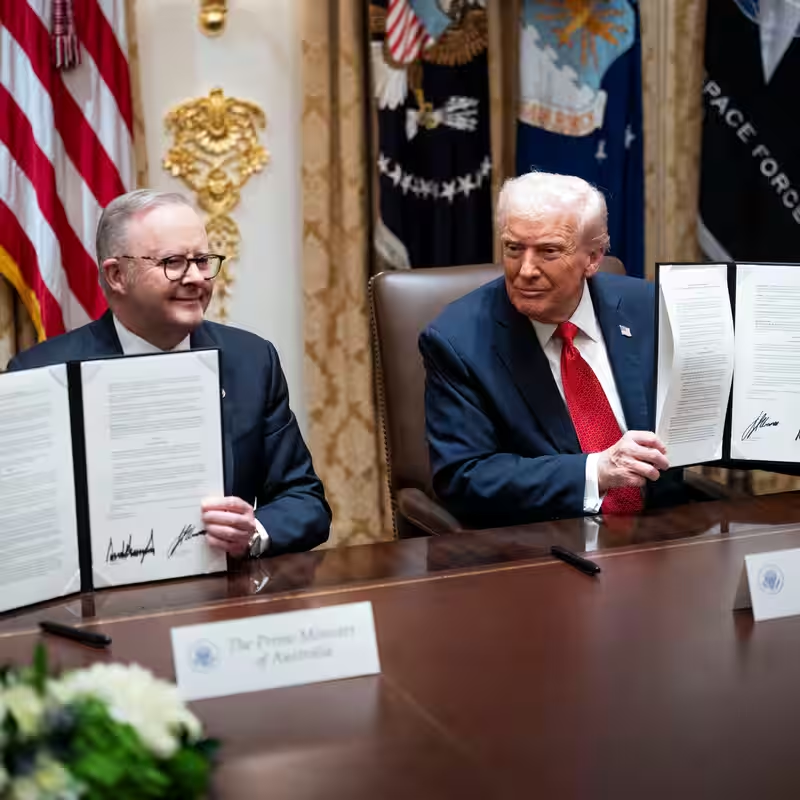Table of Contents
- The New U.S.-Australia Rare Earths Pact
- Why Rare Earths Matter
- Why Australia?
- Hurdles in Breaking China’s Monopoly
- What This Means for Global Supply Chains
- Sources
Rare Earths Deal: U.S. and Australia Join Forces
In a bold geopolitical move, the United States and Australia have announced a multibillion-dollar partnership to develop a joint rare earths supply chain—aimed squarely at reducing dependence on China. The agreement, signed by President Trump and Australian Prime Minister Anthony Albanese, signals a major escalation in efforts to secure critical minerals vital to defense, clean energy, and advanced manufacturing.
“Australia’s got reserves and mining expertise,” said one senior U.S. official. “Now, with American capital and strategic urgency, we’re building an alternative that doesn’t run through Beijing.”
Why Rare Earths Matter
Rare earth elements—17 chemically similar metals like neodymium, dysprosium, and lanthanum—are essential for everything from electric vehicle motors and wind turbines to missile guidance systems and smartphones. Despite their name, they’re not especially rare in the Earth’s crust—but they are extremely difficult and environmentally sensitive to extract and refine.
Today, China controls roughly 60% of global rare earth mining and an estimated 85–90% of refining capacity. That near-monopoly gives Beijing significant leverage in global trade and national security matters.
Key Uses of Rare Earth Elements
- Permanent magnets in EVs and wind turbines
- Phosphors in LED lighting and displays
- Catalysts in petroleum refining
- Defense tech: radar, sonar, precision-guided weapons
Why Australia?
Australia holds about 5% of the world’s known rare earth reserves and already accounts for nearly 8% of global production—second only to China. Companies like Lynas Rare Earths operate mines in Western Australia and processing facilities in Malaysia, making it the only major non-Chinese supplier at scale.
But mining is just the first step. “The real bottleneck isn’t digging—it’s refining,” explained Dr. Mei Lin, a materials scientist at MIT. “Separating individual rare earths requires complex chemistry, massive water use, and generates radioactive waste. Few countries have the infrastructure or regulatory tolerance for it.”
Hurdles in Breaking China’s Monopoly
Despite the fanfare, experts caution that building a full rare earths supply chain—from mine to magnet—will take years, if not decades.
“You can’t just flip a switch,” said James Carter, a former Pentagon supply chain advisor. “Even with billions in investment, permitting alone for a new refinery in the U.S. could take 5–7 years. And you need skilled chemists, engineers, and environmental safeguards.”
| Stage | Current Leader | U.S.-Australia Timeline Estimate |
|---|---|---|
| Mining | China (~60%) | 2–3 years (expansion) |
| Refining | China (~85–90%) | 5–8 years (new facilities) |
| Magnet Production | China (~90%) | 4–6 years (with incentives) |
What This Means for Global Supply Chains
The U.S.-Australia deal isn’t just about minerals—it’s a strategic play to de-risk Western economies from Chinese leverage. With tariffs, export controls, and tech wars intensifying, securing critical materials has become a national security priority.
The partnership includes funding for new mines in Australia, pilot refineries in Texas and Wyoming, and joint R&D into cleaner separation technologies. It also opens the door for deeper alliances with Canada, Japan, and the EU—all of whom are racing to build their own rare earths ecosystems.
“This isn’t just commerce,” said Prime Minister Albanese at the signing. “It’s about sovereignty in the 21st century.”




